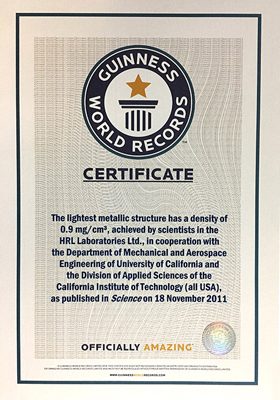
HRL Laboratories Achieves Guinness World Record for Lightest Metal
HRL Laboratories, LLC, is now on the most famous list of the best in the world, achieving the Guinness World Record for lightest metal.
 HRL researchers originally made headlines with a famous image of a metal microlattice structure resting atop an unaffected dandelion. Now the material has been vetted and confirmed by the Guinness book as having no peer among metals when it comes to weight. Made of nickel phosphorus, the microlattice is approximately 100 times lighter than Styrofoam®.
HRL researchers originally made headlines with a famous image of a metal microlattice structure resting atop an unaffected dandelion. Now the material has been vetted and confirmed by the Guinness book as having no peer among metals when it comes to weight. Made of nickel phosphorus, the microlattice is approximately 100 times lighter than Styrofoam®.
“The point of achieving the record for lightest metal was to show the flexibility of the manufacturing process,” said Bill Carter, Director of the Sensors and Materials Laboratory at HRL. “With the same process we can produce a strong and useful material that can be made with the density of aluminum all the way down to well below the density of air (excluding the air inside). Achieving a density at any point between those requires only a small change in the creation process. It can be done quickly, relatively inexpensively, and made to order.”
Carter said that there is no other material or product that enables the range of density in a manufacturing process with such relative ease and variation of material properties. Based on versatility and ease of customizable production, the potential uses of microlattice are many, including insulation, heat exchange devices, catalytic converters, airplane wings, energy-absorbent soldiers’ helmets, and vehicle blast protection.
“We’ve also been able to achieve interconnected hollow lattices with a density and surface area similar to lung tissue,” Carter said. “If you wanted to create an artificial lung, microlattice is a very viable way of doing it.”
To make a metal microlattice, an initial polymer microlattice template is customized as desired using HRL’s fast, customizable self-forming photopolymer waveguide process that can make a single template in less than a minute. That polymer template is then electroplated with layers of nickel-phosphorus according to desired density requirements. After plating, the polymer is chemically removed. The remaining hollow tubular microlattice has—in the case of the record-breaking version—wall thickness of approximately 80 nanometers, about 1,000 times thinner than the width of a human hair. The entire manufacturing process is rapid and scalable.
The Guinness Book of World Records was originally devised by the famous beer company as a reference guide for settling bar bets. Over time, it has become an iconic documentation of the world’s best feats from athletics to science. For HRL Laboratories this achievement casts a public light on their cutting-edge materials research and provides the public a glimpse into how HRL is enabling life-changing technologies.
HRL Laboratories, LLC, California (hrl.com) pioneers the next frontiers of physical and information science. Delivering transformative technologies in automotive,aerospace and defense, HRL advances the critical missions of its customers. As a private company owned jointly by Boeing and GM, HRL is a source of innovations that advance the state of the art in profound and far-reaching ways.
Media Inquiries: media[at]hrl.com, (310) 317-5000